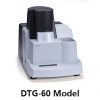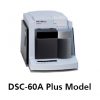Low-Temperature Differential Scanning Calorimetry Measurements with the Upmost Control
Combining the sensitivity and high resolution of Shimadzu’s DSC-60 Plus series with auto-cooling results in robust systems for controlled, consecutive measurements below ambient temperature. Auto-cooling systems available for the DSC-60 Plus series include the TAC-60L liquid nitrogen auto cooling system for very low temperature work and the TAC-60i mechanical auto-cooling system when measuring slightly below ambient temperature.
Four auto-cooling DSC-60 Plus series systems are available:
- DSC-60 Plus model with TAC-60i mechanical auto-cooling system
- DSC-60A Plus model with an autosampler and TAC-60i mechanical auto-cooling system
- DSC-60 Plus model with TAC-60L liquid nitrogen auto-cooling system
- DSC-60A Plus model with an autosampler and TAC-60L liquid nitrogen auto-cooling system
Mechanical Auto-Cooling from -50 to 500°C without the Need for Liquid Nitrogen
Consecutive measurements at temperatures between -50 and 500°C are enabled using the DSC-60 Plus series with the TAC-60i mechanical auto-cooling system. The system consists of an immersion cooler and does not use liquid nitrogen.
Consistent Auto-Cooling Between -130 and 500°C with Liquid Nitrogen
The TAC-60L liquid nitrogen auto-cooling system reduces pulsation and maintains a stable baseline by controlling the amount of liquid nitrogen in the DSC-60 Plus series main unit’s cooling chamber to keep a constant supply flow rate. In addition, when sub-ambient measurement is not required, the detector and furnace design enables the DSC-60 Plus series to be run to 500°C without needing liquid nitrogen.
Automated Measurements at Low Temperature
Compatibility of the DSC-60A Plus model with the TAC-60L liquid nitrogen auto-cooling system and the TAC-60i mechanical auto-cooling system results in automated low-temperature differential scanning calorimetry measurements of up to 24 samples. Between tests, these cooling units return the furnace to a specified temperature to eliminate condensation during sample exchange.





